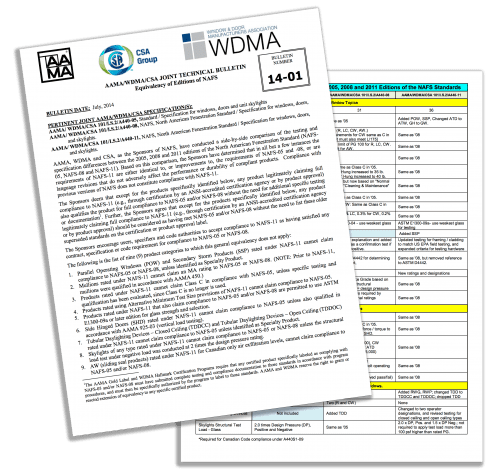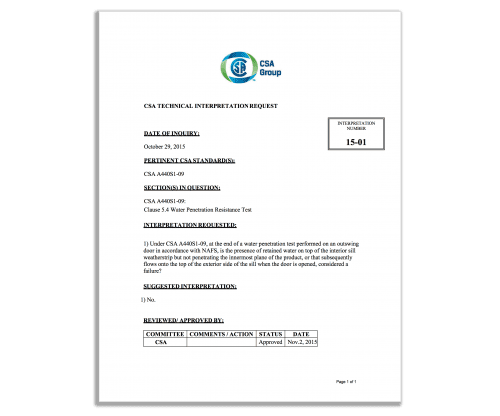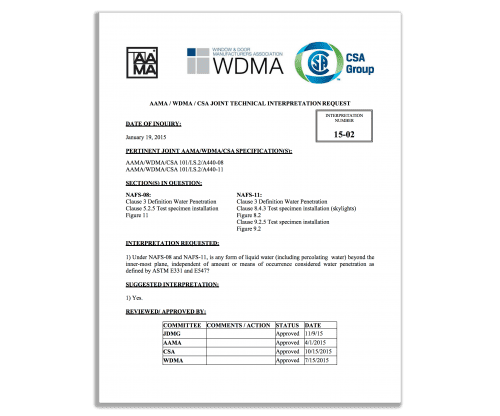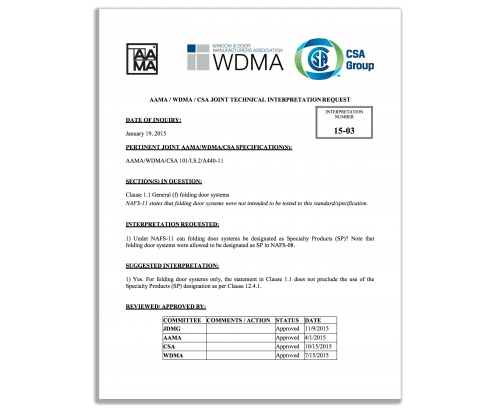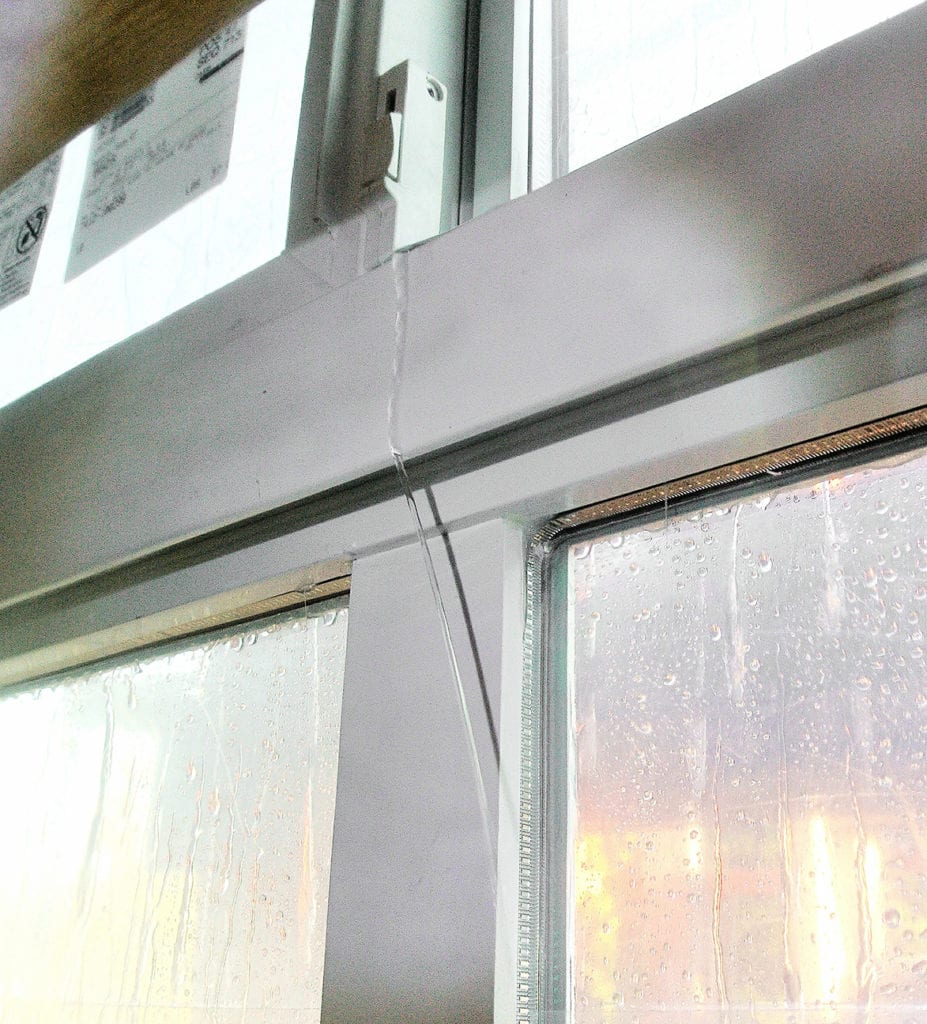This week, I would like to introduce you to five technical interpretation (TI) bulletins relevant to users of the NAFS standard in Canada.
Four of these bulletins are published by the Joint Document Management Group (JDMG)—the organization responsible for managing the North American Fenestration Standard (NAFS).
The JDMG is comprised of members from each of the three associations responsible for the creation of NAFS: the American Architectural Manufacturers Association (AAMA), the US-based Window and Door Manufacturers Association (WDMA), and the Canadian Standards Association (CSA). As such, each TI bulletin undergoes a strict approval process with committees from each of the three organizations reviewing the documents prior to publication.
In addition to the four NAFS-specific TI bulletins released by the JDMG, the CSA has also independently published a TI that applies only to products sold in Canada, and it concerns CSA A440S1, known as the Canadian Supplement to NAFS.
Stay on Top of Changes to Standards!
Why are TIs necessary? Users of standards often have questions about unclear requirements or other matters of concern, and some standards-writing bodies have policies that allow for technical interpretations to be made in response. These interpretations serve to inform all affected parties about official decisions made in response to requests from users of the standards.
The TI bulletins are publicly available on the CSA website, but gaining access to them through CSA requires setting up an account. (Information on how to do so appears below.) You can also download them from the links in this post.
Four Technical Interpretation Bulletins for NAFS
There are four specific bulletins that I would like to introduce to you that have particular relevance to the application of NAFS:
- JDMG TB 14-01
- JDMG TI 15-01
- JDMG TI 15-02
- JDMG TI 15-03
JDMG TB 14-01 compares 2005, 2008 and 2011 editions of NAFS
Although the first edition of NAFS—published in 2005—was too late to make it into the 2005 National Building Code of Canada (NBCC), the 2008 edition was referenced in the 2010 NBCC and several codes based on it, such as the 2012 BCBC and the 2014 Vancouver Building Bylaw (VBBL). In mid-2015, the NBCC released an update referencing the 2011 edition of NAFS (NAFS-11). Depending where you are in Canada, either the 2008 or the 2011 version of NAFS may be in effect.
Technical bulletin JDMG TB 14-01 summarizes the significant differences between these three versions of NAFS, and will be useful for anyone concerned with whether testing to one of these versions of NAFS is equivalent for the purposes of compliance, or relevant to a particular matter. For example, a change to the structural test load requirements for unit skylights between NAFS-08 and NAFS-11 will be relevant only to that product type.
Download JDMG TB 14-01 to read the bulletin in its entirety.
JDMG TI 15-01 cleans up test specimen installation
Of the four technical interpretations, this is “the biggie”, and cleans up the sloppy installation language in NAFS that some manufacturers have abused to obtain performance ratings that could never be replicated in real-world installations.
TI 15-01 provides much-needed clarification for how test specimens are installed for NAFS testing. It addresses several questionable practices I have seen in test labs—practices that the lab personnel I spoke with recognized as being inappropriate for correctly rating product performance, but that they could not prevent because of the standard’s permissive installation requirements.
Here is my take on what the four items in this TI are getting at:
- The installation method cannot prevent observation of potential water leakage around the perimeter of the product framing. Lab technicians need to be able to see whether water is leaking through frame joints. That means there should be no continuous wet seal, or continuous installation angle around the perimeter of the interior side of the window, door or skylight that would prevent them from doing so.
- No part of the framing or glass may touch the test wall at any point during the test.
- The test specimen installation instructions that manufacturers provide to test labs must be consistent with the perimeter sealing and anchoring practices shown in published field installation instructions for the product being tested. Installation methods that boost product performance but that cannot be implemented in the field can no longer be used. Sad to say, such measures have, in my experience, been used all too widely in both Canada and the US. The NAFS language on test specimen installation is unfortunately vague enough to have allowed such practices, and this interpretation clarifies that test specimen installation must be realistic and consistent with the manufacturer’s real-world instructions, and if those do not exist, with real-world installation practices in general.
- When a manufacturer’s standard installation instructions obscure “proper conduct and observation of the test,” they may not be used for NAFS testing. NAFS requirements for observation (see item 1) take precedence.
While use of continuous metal angles or continuous sealant at the interior perimeter of the tested product may legitimately be one of the manufacturer’s standard installation methods, this TI makes it clear that the NAFS requirements for observation must take precedence. The continuous sealant (or metal angle) may need to be deleted, or be made sufficiently discontinuous with gaps wide enough to allow observation of the clearance gap around the product.
To sum it up, I would this TI clarifies that NAFS test specimens need to be installed in a way that accords with a manufacturer’s real-world installation methods and that also allows observation of the gap between the test fixture and the product perimeter to observe things like water penetration through joints. A long time in coming, but welcome nonetheless.
Do you have a different take on intent or significance of this TI? Or your own experiences to share? If so, feel free to start a discussion in the comments section below.
Download JDMG TI 15-01 to read the bulletin in its entirety.
JDMG TI 15-02 clarifies that “percolating water” can fail a water test
Sometimes during a lab water test, water does not quite flow over the innermost edge of a window or door, but bubbling air in even small amounts of standing water may result in “spitting” tiny droplets over the edge. If that happens, it is a failure of the test. The innermost plane of the fenestration system is the thin red line that must never be crossed!
Download JDMG TI 15-02 to read the bulletin in its entirety.
JDMG TI 15-03 allows folding doors to continue to be tested as Specialty Products under NAFS-11
Unlike NAFS-08, NAFS-11 specifically excluded folding door products from its scope. Many manufacturers of these products (also called “accordion doors”, “concertina doors”, “bifold doors” or “folding-sliding doors”) had tested them as Specialty Products under NAFS-08. The Specialty Product category is intended to allow the NAFS testing of products not specifically identified as product types in NAFS-08 or NAFS-11. The exclusion of folding doors from NAFS-11 inadvertently put this practice into jeopardy, and this TI sets things right. Manufacturers can continue to test and certify these products for air-water-structural ratings under NAFS-11.
Download JDMG 15-03 to read the bulletin in its entirety.
One CSA Technical Interpretation for the Canadian Supplement to NAFS
In addition to the four NAFS-related TI Bulletins discuss above, I’d like to call your attention to one more technical interpretation: CSA S1 TI 15-01. This particular TI Bulletin is published by CSA, and as such only applies to the CSA A440S1-09, the Canadian Supplement to NAFS.
Clause 5.4 of the Canadian Supplement has different failure criteria for the water penetration resistance test than the NAFS standard, and it is the CSA definition that applies to products sold in Canada.
CSA S1 TI 15-01 addresses water testing of outswing doors
At the conclusion of a water test of an outswing side hinged door tested to the water penetration resistance criteria of CSA A440S1-09, sometimes a bit of standing water is retained at the top of the weatherstrip of the door sill. When the door is opened it may remain there, or subsequently flow onto the exterior side of the sill. This is not considered a failure, as no water penetrates the innermost plane of the door sill.
Download S1 TI 15-01 to read the bulletin in its entirety.
Where Can I Find the Bulletin and Technical Interpretation Documents?
You can access the TI bulletins from the communities page of the CSA website, where you will be required to create a quick and free account. Once you log in with your credentials, you will have full access to the downloadable documents, but you’ll have to find them first: search for “NAFS Technical Interpretation” in the upper right-hand corner search bar, or navigate to Explore communities > Construction and Engineering > Sub communities > Fenestration.
For ease of access, I have also included links to download each TI bulletin discussed:
- Download JDMG TB 14-01
- Download JDMG TI 15-01
- Download JDMG TI 15-02
- Download JDMG TI 15-03
- Download S1 TI 15-01

